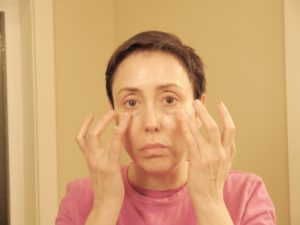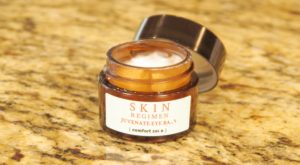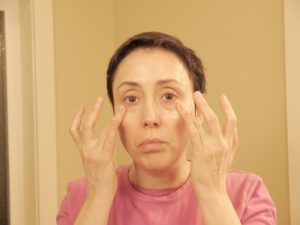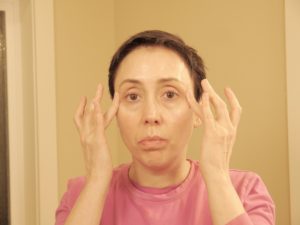Eye Cream
 Many of my clients wonder why I recommend using an eye cream as part of their regular skin care regimen. They’re curious why their normal washing and moisturizing isn’t good enough. To start, lets discuss the special skin around your eyes. It’s actually thinner, and more sensitive than the rest of your skin. As a result, it needs to be treated even more delicately in terms of what types of skin care products are used around the eyes.
Many of my clients wonder why I recommend using an eye cream as part of their regular skin care regimen. They’re curious why their normal washing and moisturizing isn’t good enough. To start, lets discuss the special skin around your eyes. It’s actually thinner, and more sensitive than the rest of your skin. As a result, it needs to be treated even more delicately in terms of what types of skin care products are used around the eyes.
One of the many benefits of using eye creams is that they’re specially formulated for this thinner, more sensitive area around your eyes. You’ll also find that the area around your eyes experiences unique skin problems like dark circles, crow’s feet and sagging. Again, eye creams are made to address these specific issues. As a result, they are often formulated with specialty ingredients not always indicated for the whole face but just this special, delicate area.
 The skin around the eyes shows signs of aging more quickly than other areas of the face does. This thinness makes it more delicate and vulnerable, and it’s more prone to allergic reactions than other facial skin. The skin around the eyes also gets a much greater workout; every time you move your eyes, whether you squint, smile or widen them in surprise, you’re working out the tiny muscles around your eyes. Over time, this skin dries out and forms small wrinkles, sometimes called crow’s feet. Smoking and exposure to the sun’s harmful ultraviolet rays can also encourage wrinkles to form. cause the skin to swell enough to lessen the appearance of wrinkles. Fine lines and wrinkles can also come from both sun damage and your skin making less collagen as you age. Collagen helps maintain skin’s elasticity. Vitamin C, peptides, and retinol have boosted collagen production, studies of skin creams show. Ceramide and hyaluronic acid also help; these are moisturizers that help prevent water loss in the skin and improve elasticity.
The skin around the eyes shows signs of aging more quickly than other areas of the face does. This thinness makes it more delicate and vulnerable, and it’s more prone to allergic reactions than other facial skin. The skin around the eyes also gets a much greater workout; every time you move your eyes, whether you squint, smile or widen them in surprise, you’re working out the tiny muscles around your eyes. Over time, this skin dries out and forms small wrinkles, sometimes called crow’s feet. Smoking and exposure to the sun’s harmful ultraviolet rays can also encourage wrinkles to form. cause the skin to swell enough to lessen the appearance of wrinkles. Fine lines and wrinkles can also come from both sun damage and your skin making less collagen as you age. Collagen helps maintain skin’s elasticity. Vitamin C, peptides, and retinol have boosted collagen production, studies of skin creams show. Ceramide and hyaluronic acid also help; these are moisturizers that help prevent water loss in the skin and improve elasticity.
 Skin under the eyes can be prone to puffiness if fluid builds up there — allergies and sinus problems can also cause the eyes to puff. When the epidermis becomes thinner and the underlying veins become more prominent, dark circles can form. Heredity, lack of sleep, too much sun exposure and aging can all cause dark circles. Unlike skin on the rest of your face, the eye area does not contain oil glands that can help keep this skin moist. This is part of the reason why beauty companies and experts recommend using a separate eye cream.
Skin under the eyes can be prone to puffiness if fluid builds up there — allergies and sinus problems can also cause the eyes to puff. When the epidermis becomes thinner and the underlying veins become more prominent, dark circles can form. Heredity, lack of sleep, too much sun exposure and aging can all cause dark circles. Unlike skin on the rest of your face, the eye area does not contain oil glands that can help keep this skin moist. This is part of the reason why beauty companies and experts recommend using a separate eye cream.
Eye creams usually contain emollients, or moisturizers, that can help hydrate the drier eye skin and help it to look smoother. It also causes the skin to swell enough to lessen the appearance of wrinkles. To combat the appearance of wrinkles, eye creams can also contain ingredients that help boost collagen. Collagen is a major protein that’s found in the fibers of connective tissue, cartilage and bone. It keeps skin strong and helps smooth out wrinkles, but your skin produces less of it as you get older. Eye creams with retinol, a derivative of vitamin A, are marketed to increase collagen production. Antioxidant ingredients, such as vitamin C, and peptides also assist in retaining collagen in the skin.
Ingredients such as calendula are used to fight under-eye puffiness. Puffiness is a buildup of fluid and blood under the eyes. Some studies show that caffeine can help circulation, which could reduce puffiness. Other studies show that cold temperatures are just as effective to treat puffiness. That’s why some people refrigerate their eye creams.
Some creams can even contain caffeine, which can help reduce the appearance of bags under the eyes. Eye creams fight dark circles by temporarily puffing up skin so the blood vessels underneath aren’t as prevalent. Dark circles under the eyes come from genes, sun damage, age, and blood build-up. Sodium ascorbate, or vitamin C, can thicken the skin and help conceal dark circles after about 6 months. Niacinamide, or vitamin B3, and kojic acid can lighten dark circles.
If you have oily skin, you may want to consider using an eye gel because it doesn’t contain the same moisturizers, which could increase the oil production in your skin.
 Eye creams also tend to be thicker than facial lotions, and the thicker product will stay on the thin, mobile skin a little better. Be sure to apply the cream before you put on your makeup so that your skin absorbs the active ingredients.
Eye creams also tend to be thicker than facial lotions, and the thicker product will stay on the thin, mobile skin a little better. Be sure to apply the cream before you put on your makeup so that your skin absorbs the active ingredients.
To find an eye cream that will help prevent wrinkles, treat any you may already have, and moisturize the fragile eye area, I suggests reading the ingredient label to see if the product contains the following:
– A less potent percentage (one percent) of glycolic acid, which promotes cell turnover, than what you’d use on the rest of your face.
– Peptides, which stimulate collagen production.
– Moisturizers like glycerin, urea, or hyaluronic acid, which help plump up fine lines temporarily.
Use your ring fingertip to apply (since it’s the least strongest finger), and pat a few dots of eye cream from the outer corner of your eye to right below your tear duct. Then, gently rub it into your skin using gentle inward sweeping motions, again only using your ring finger.
